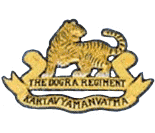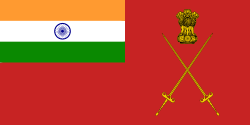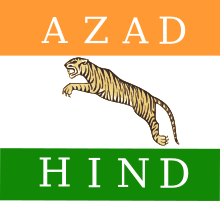Dogra Regiment
| Dogra Regiment | |
|---|---|
 Regimental Insignia of the Dogra Regiment | |
| Active | 1877 – Present |
| Country |
|
| Branch | Indian Army |
| Type | Line Infantry |
| Regimental Centre | Faizabad, Uttar Pradesh |
| Motto(s) | Kartavyam Anvatma (Duty Before Death) |
| War Cry | Jwala Mata Ki Jai (Victory to Goddess Jwala) |
| Decorations |
3 Victoria Cross 44 Military Cross One Ashoka Chakra 13 Maha Vir Chakras 18 Kirti Chakras 10 Yudh Seva Medals 46 Vir Chakras one Vir Chakra and Bar one Padma Bhushan 21 Uttam Yudh Seva Medals 26 Param Vishisht Seva Medals 33 Ati Vishisht Seva Medals 40 Shaurya Chakras 189 Sena Medals 31 Vishisht Seva Medals 188 Mention-in-Despatches and 263 COAS's Commendation Cards |
| Battle honours |
Jhangar, Rajauri, Uri, Asal Uttar, Haji Pir, Raja Picquet, OP Hill, Siramani, Suadih, Dera Baba Nanak and Chandgram
Theatre Honours |
| Commanders | |
| Current commander | Lt General Ranbir Singh[1] |
| Notable commanders | General Nirmal Chander Vij |
| Insignia | |
| Regimental Insignia | Tiger revered as the mount of the Goddess Durga, who is a widely worshipped deity in the Dogra Hills |
The Dogra Regiment is an infantry regiment of the Indian Army. The regiment traces its roots directly from the 17th Dogra Regiment of the British Indian Army. When transferred to the Indian Army like its sister regiments, the numeral prefix (in the case of the Dogra Regiment, 17) was removed.
History
Formation
The regiment was formed in 1922 through the amalgamation of three separate regiments of Dogras into the 17th Dogra Regiment. They were:
- 1st Battalion – formerly the 37th (Prince of Wales's Own) Dogras
- 2nd Battalion' – formerly the 38th Dogras
- 3rd Battalion – formerly the 1st Battalion, 41st Dogras
- 10th (Training) Battalion – formerly the 2nd Battalion, 41st Dogras
The 41st Dogras were an infantry regiment of the British Indian Army that traced its origins to 1900, when it was raised as the 41st (Dogra) Bengal Infantry. After World War I, the Indian government reformed the army, moving from regiments with a single battalion to multi battalion regiments.[2] It dropped '17th' from its title in 1945 and was allocated to India upon its independence in 1947.
The regiment has produced one Chief of Army Staff, General Nirmal Chander Vij. Vij also served as the 10th Colonel-in-Chief of the Dogra Regiment and the Dogra Scouts.
Recruiting
The regiment recruits from the Dogra people of Jammu and Kashmir, Himachal Pradesh and the hill regions of Punjab. Enlisting in the army is seen as an honourable pursuit for Dogras, with the earnings of the soldiers of the regiment forming a sizeable part of the local economy. Soldiering has not only become a substantial part of the economic structure of the Dogra Hills, but created social and cultural traditions built on the people's association with the army.
Units
- 2nd Battalion
- 3rd Battalion
- 4th Battalion
- 5th Battalion
- 6th Battalion
- 7th Battalion
- 8th Battalion
- 9th Battalion
- 10th Battalion
- 11th Battalion
- 12th Battalion
- 13th Battalion
- 14th Battalion
- 15th Battalion
- 16th Battalion
- 17th Battalion
- 18th Battalion
- 19th Battalion
- 20th Battalion[3]
Others:
- 1st Battalion was transformed in 1981 into the 7th Battalion, Mechanised Infantry Regiment
Indo-Pakistani War of 1971
On the eastern front, the 9th battalion, Dogra Regiment (9 Dogra) was responsible for the fall of Suadih, a small village in East Pakistan that was a strong bastion of the Pakistan Army's most fortified position in the country. This led to the ultimate liberation of East Pakistan and a victory for the Indian Army. For this herculean task, 9 Dogra was awarded the battle honour of Suadih.
Kargil War
The 5th battalion fought in the Kargil War to capture Tiger Hill.
Battle honours
Before Indian independence, the Dogras had to their credit three Victoria Crosses and 44 Military Crosses besides 312 other awards. Two battalions of the 17th Dogra Regiment (the 2nd and 3rd), also fought in the Malayan Campaign. After the Fall of Singapore, a large number of the captured troops later went on to join the Indian National Army.[4]
Pre-Independence
Combined battle honours of 37th (Prince of Wales's Own) Dogras, 38th Dogras, 41st Dogras:
World War I
- La Bassée 1914
- Festubert 1914–1915
- Givenchy 1914
- Neuve Chapelle
- Aubers
- France and Flanders 1914–15
- Egypt 1915
- Megiddo
- Nablus
- Palestine 1918
- Tigris 1916
- Kut al-Amara 1917
- Baghdad
- Mesopotamia 1915–18
- Aden
- North-West Frontier 1915–1917
- Afghanistan 1919
World War II
- Kota Bahru
- Malaya 1941–42
- Donbaik
- Nunshigum
- Magwe
- Kennedy Peak
- Burma 1942–45
Post-Independence
- Jhangar 1947
- Rajauri 1947
- Jammu and Kashmir 1947–48
- Hajipir
- Raja Picquet-Chand Tekri
- OP Hill (NL 1053)
- Jammu and Kashmir 1965
- Asal Uttar
- Dograi
- Punjab 1965
- Suadhi
- Siramani
- Chauddagram
- East Pakistan 1971
- Dera Baba Nanak
References
- ↑ https://economictimes.indiatimes.com/news/defence/lt-gen-ranbir-singh-avenges-death-of-soldiers-from-his-dogra-regiment/articleshow/54616578.cms
- ↑ Sumner, Ian (2001). The Indian Army 1914–1947. Osprey Publishing. ISBN 1-84176-196-6.
- ↑ Dogra Regiment
- ↑ Fay 1993, p. 137

